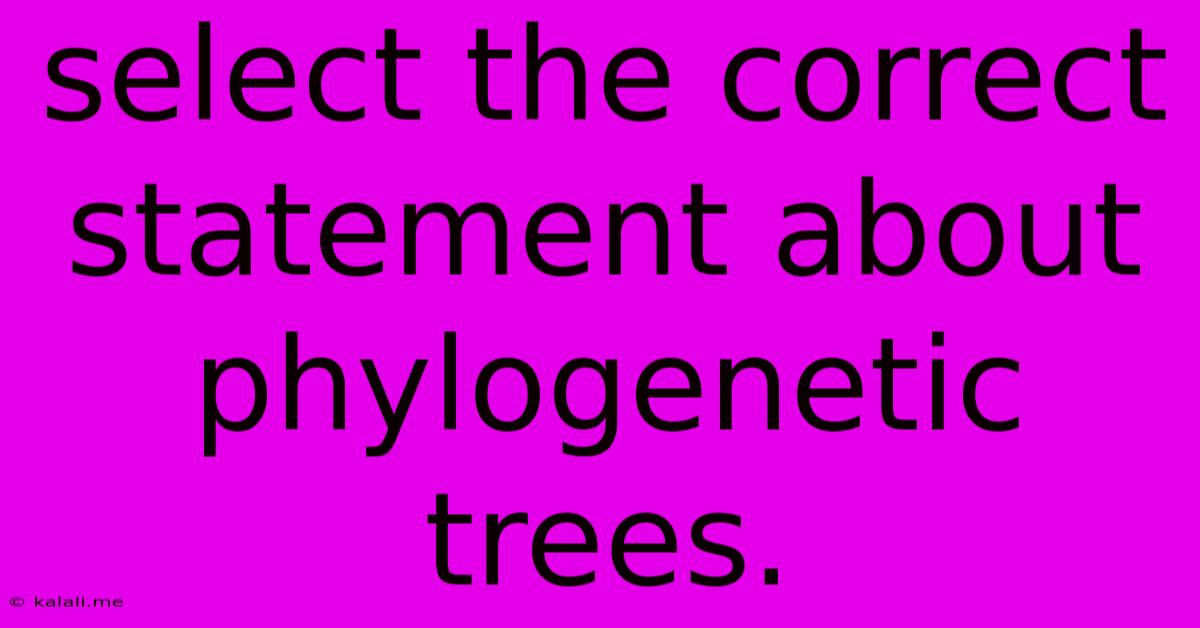Select The Correct Statement About Phylogenetic Trees.
Kalali
Jun 16, 2025 · 3 min read

Table of Contents
Select the Correct Statement About Phylogenetic Trees: A Deep Dive into Evolutionary Relationships
Phylogenetic trees, also known as evolutionary trees, are visual representations of the evolutionary history of a group of organisms. They depict the relationships among different species, showing how they are related through common ancestors. Understanding how to interpret these diagrams is crucial in biology and evolutionary studies. This article will delve into the core concepts of phylogenetic trees and help you select the correct statement about them from a given set of options (which you would provide in a real-world scenario). We will cover key features and common misconceptions to build a solid understanding.
What Phylogenetic Trees Show (and Don't Show):
Phylogenetic trees illustrate the evolutionary relationships among organisms based on shared characteristics, often genetic sequences or morphological traits. They are hypotheses, not definitive facts, and can be refined as new data emerges. Crucially, they don't show the absolute time since divergence or the exact order of evolution in every instance – this is often inferred but not always directly represented.
Key Features of Phylogenetic Trees:
-
Nodes: These represent common ancestors. A node where two branches diverge indicates a speciation event, where a single ancestral lineage splits into two distinct lineages.
-
Branches: These represent evolutionary lineages, showing the relationship between different species or groups. Branch length sometimes reflects evolutionary time or the amount of genetic change, but this isn't always the case (some trees are drawn with equal branch lengths regardless of the time scale).
-
Tips (or Terminals): These represent the extant (currently living) or extinct species or groups at the end of each evolutionary lineage.
-
Root: This represents the most recent common ancestor of all the organisms in the tree. Not all trees are rooted; unrooted trees show relationships but don't specify the root ancestor.
Common Misinterpretations of Phylogenetic Trees:
-
Branch Length: As mentioned, branch length does not always correspond directly to time. Some phylogenetic trees are drawn to emphasize evolutionary relationships rather than temporal scales.
-
Relative Position of Tips: The horizontal positioning of the tips doesn't indicate anything about evolutionary advancement or "superiority." All tips represent lineages that have evolved independently for a certain period.
-
Clades: A clade is a group of organisms that includes a common ancestor and all of its descendants. It's important to understand the concept of monophyletic groups (true clades) versus paraphyletic or polyphyletic groupings.
How to Select the Correct Statement:
When faced with multiple statements about phylogenetic trees, carefully examine each one considering the points outlined above. Look for statements that accurately reflect:
- The meaning of nodes and branches.
- The representation of evolutionary relationships.
- The potential for ambiguity in branch lengths.
- The concept of clades and monophyletic groupings.
- The hypothesis nature of phylogenetic trees.
By understanding these fundamental aspects, you'll be able to confidently select the correct statement regarding phylogenetic trees from any given options, correctly interpreting the evolutionary information presented within these powerful diagrams. Remember that the most accurate statements reflect the inherent uncertainties and the ongoing refinements of phylogenetic analyses as new data become available.
Latest Posts
Latest Posts
-
How To Create Clickable Image In Html
Jun 16, 2025
-
What Are The Factors Of 121
Jun 16, 2025
-
What Is A Theme Of The Passage
Jun 16, 2025
-
A Company That Provides Access To The Internet
Jun 16, 2025
-
Which Word Is Closest In Meaning To The Underlined Word
Jun 16, 2025
Related Post
Thank you for visiting our website which covers about Select The Correct Statement About Phylogenetic Trees. . We hope the information provided has been useful to you. Feel free to contact us if you have any questions or need further assistance. See you next time and don't miss to bookmark.